Overview
Coding challenges are a common hurdle that developers face in software development. To navigate these complexities, understanding essential Object-Oriented Design (OOD) patterns is crucial. Patterns like Singleton, Factory Method, and Observer provide targeted solutions to specific coding challenges. Each pattern not only enhances code maintainability but also improves flexibility and performance, ultimately streamlining the development process.
Furthermore, these design patterns serve as frameworks that guide developers in creating efficient and scalable software. For instance, the Singleton pattern ensures a class has only one instance, which can be particularly beneficial in managing shared resources. Similarly, the Factory Method pattern allows for the creation of objects without specifying the exact class, promoting flexibility in code.
In addition, the Observer pattern facilitates communication between objects, enhancing responsiveness to changes in the application state. By leveraging these patterns, developers can significantly boost their productivity and the overall quality of their code.
Are you ready to explore the advantages of implementing these OOD patterns in your projects? Embracing these design strategies can lead to more maintainable and efficient software solutions. Discover the tools available on platforms like Kodezi that can help you integrate these patterns into your workflow effectively.
Introduction
In the ever-evolving landscape of software development, developers often face significant challenges in creating robust and maintainable applications. Mastering design patterns is crucial to overcoming these hurdles. This article delves into essential design patterns, including the Singleton, Factory Method, and Observer patterns, each serving unique purposes in object-oriented design. By exploring how these patterns optimize resource management, enhance flexibility, and streamline communication between objects, developers can gain valuable insights into their practical applications.
Furthermore, the integration of innovative tools like Kodezi addresses these challenges effectively. With features such as automated debugging and facilitating complex object creation, Kodezi provides a transformative approach to implementing design patterns. By understanding and applying these patterns, developers can significantly improve code quality and efficiency.
In addition, using Kodezi can elevate the development process, ensuring that software solutions are both effective and adaptable in today's fast-paced environment. By embracing these tools, developers can enhance their productivity and deliver higher-quality code. Are you ready to explore the tools available on the Kodezi platform and elevate your coding practices?
Kodezi | Professional OpenAPI Specification Generator - AI Dev-Tool: Enhance Your OOD with Automated Debugging
Developers often face significant challenges in maintaining high-quality code and efficient workflows. Kodezi emerges as an essential tool for those focused on Object-Oriented Design (OOD), addressing these challenges effectively. The Kodezi CLI feature independently enhances codebases by detecting and resolving problems in real-time, which is crucial for upholding quality standards. By incorporating Kodezi into your development workflow, you can significantly enhance your practices related to OOD design patterns, facilitating the effective implementation of design patterns. Kodezi not only achieves this but also mitigates the risk of mistakes that can undermine software integrity.
For instance, a development team that utilized Kodezi reported a remarkable 37% enhancement in load times, attributed to its ability to swiftly identify and resolve performance bottlenecks and security concerns in the code. This example underscores the tool's effectiveness in enhancing user engagement and retention.
Furthermore, consider the competitive edge of companies that leverage low-code and no-code platforms; they are 14 times more likely to deliver apps faster than their competitors. This statistic highlights the efficiency benefits of tools like Kodezi in the context of OOD design patterns. As the trend towards automation in programming continues to grow, with 63% of enterprise software companies now implementing some form of generative AI in their development workflows according to Gartner, Kodezi empowers developers to streamline their processes. Ultimately, this fosters a more productive and efficient development environment.
To get started, Kodezi offers a 5-minute quickstart and demo, making it easy for teams to integrate this powerful tool into their existing workflows. Additionally, Kodezi CLI supports various programming languages, ensuring versatility for diverse development needs. Why not explore how Kodezi can transform your coding practices today?
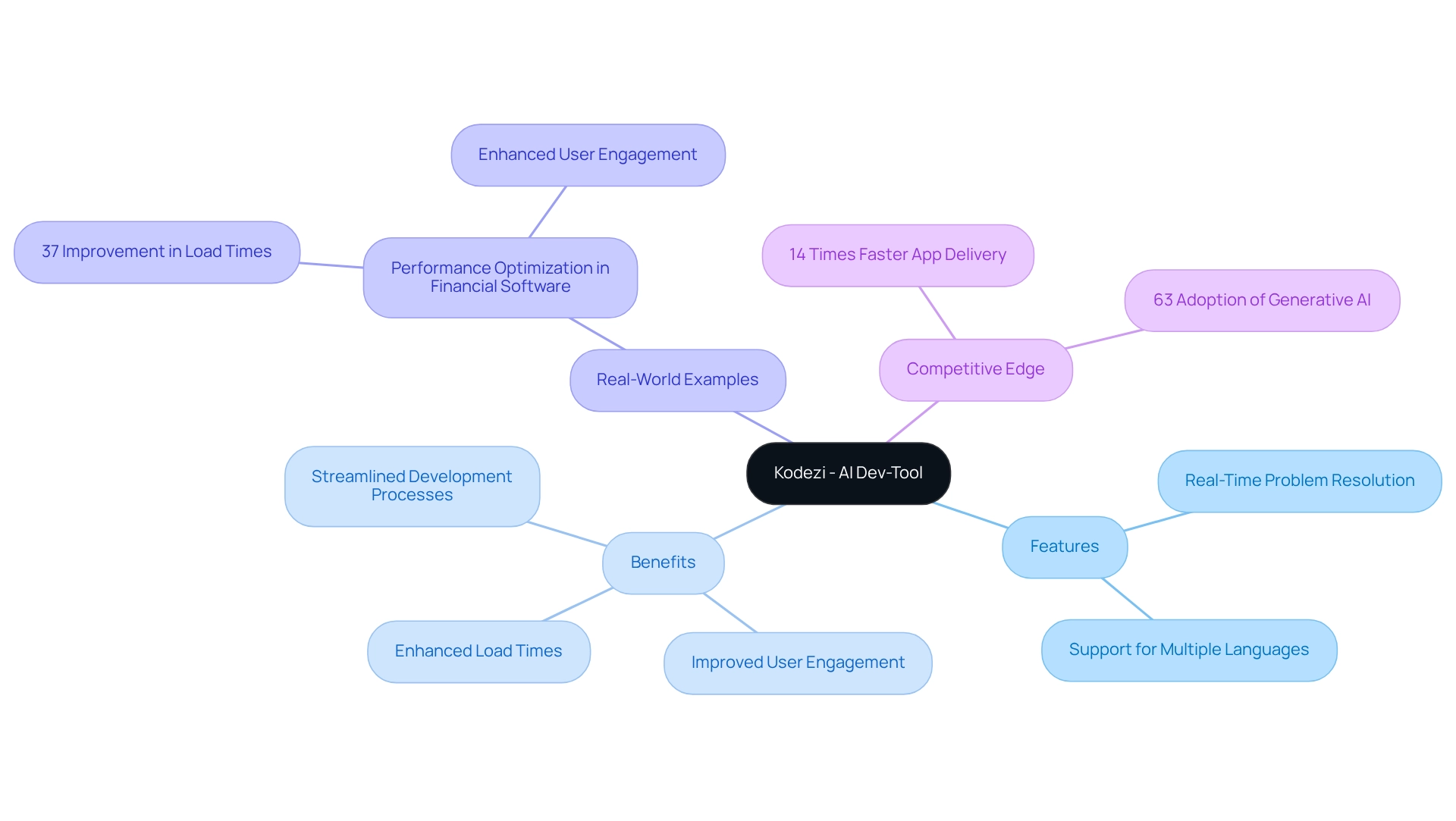
Singleton Pattern: Ensure a Single Instance for Resource Management
Developers often face significant coding challenges, particularly when it comes to managing shared resources effectively. The Singleton design pattern is an example of good design patterns that addresses this by limiting a class to a single instance, providing a global access point to that instance. This design is essential in scenarios where shared resources, such as configuration managers or connection pools, are critical throughout a system. By adopting the Singleton approach, developers can optimize resource management and enhance software responsiveness.
For instance, in logging systems, a Singleton ensures that all components of an application log messages to a unified output. This fosters consistency and minimizes overhead. However, it's crucial to consider that the Singleton design can lead to unexpected behavior in multi-threaded environments, which developers must navigate carefully. Have you encountered challenges with resource management in your projects?
Statistics reveal that the Singleton design is widely embraced in software development, with numerous architects underscoring its importance in managing shared resources effectively. As Vishal Gangapuram notes, "The Singleton Design Technique is one of the creational design approaches and ensures that a class has only one instance while providing a global point of access to it." Recent trends indicate a growing reliance on the Singleton approach for resource management, particularly in agile environments where efficiency is paramount.
Moreover, case studies have highlighted serialization challenges that can arise with Singleton classes, especially when a Singleton class implements Serializable. This may inadvertently lead to the creation of new instances upon deserialization. To mitigate this issue, it is advisable to implement the readResolve method, ensuring that the deserialized instance aligns with the existing Singleton instance. Thus, the Singleton property is preserved.
Overall, the good design patterns, particularly the Singleton design, serve as a fundamental tool in object-oriented architecture, streamlining resource management and enhancing software performance. Are you ready to explore how the Singleton design can improve your coding practices?
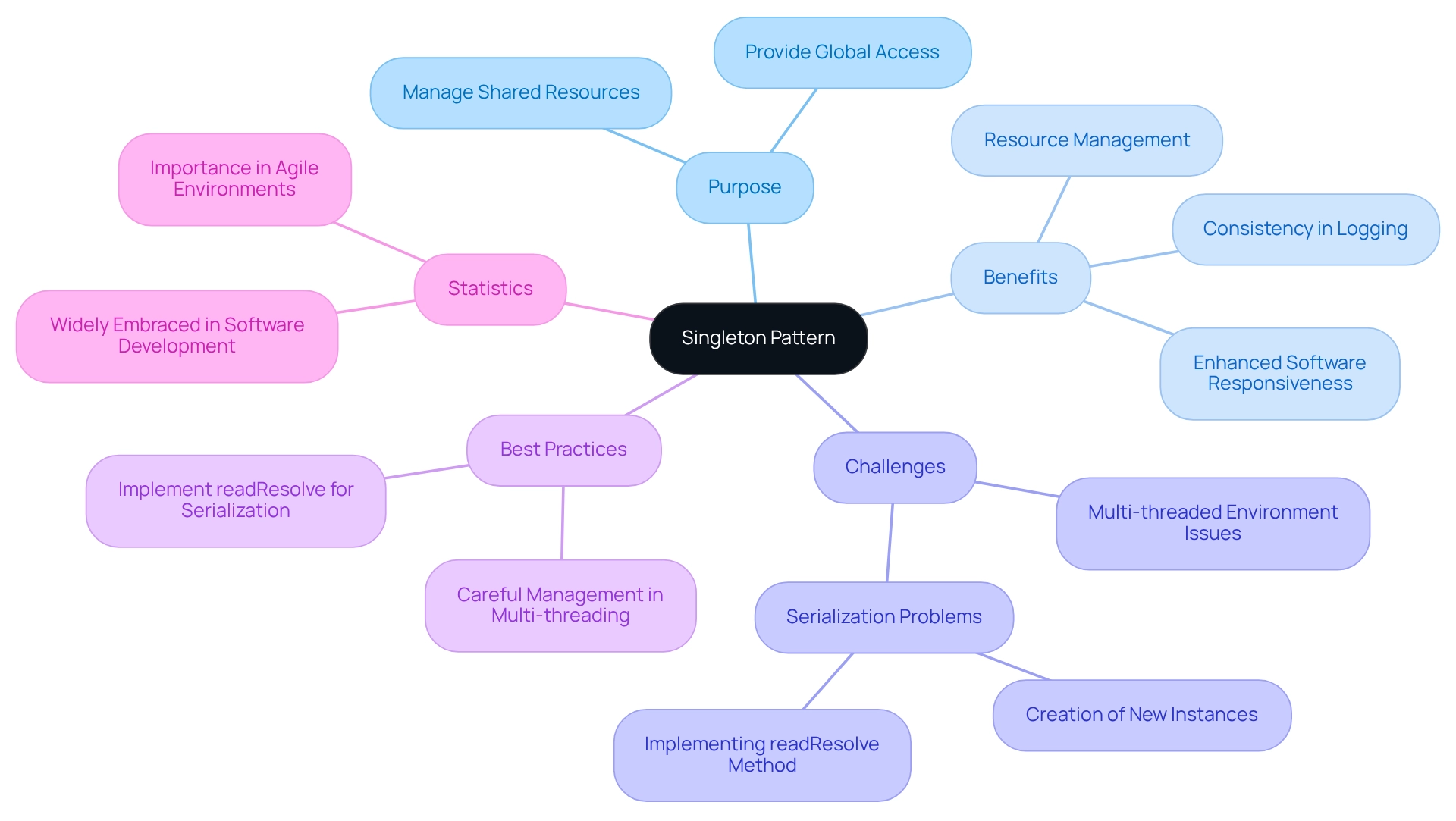
Factory Method Pattern: Create Objects Without Class Specification
Developers often face significant challenges in object creation within their applications. The Factory Method is one of the ood design patterns that addresses these issues by establishing an interface for object creation, empowering subclasses to determine the specific types of objects produced. This approach fosters loose coupling, freeing clients from the necessity of knowing the concrete classes being instantiated. For example, in graphics applications, a ShapeFactory can generate various shapes—such as circles or squares—without requiring the client to understand the intricacies of each shape's implementation. This streamlines the code and enhances maintainability and flexibility, allowing developers to introduce new shapes effortlessly.
Furthermore, the case study titled 'Factory Method Pattern Key Components' outlines essential elements:
- Creator
- Concrete Creator
- Product
- Concrete Product
These components collaborate to establish how entities are generated without detailing their specific classes. This structure promotes greater flexibility and extensibility in the system, enabling clients to create custom implementations of products while maintaining a consistent interface for object creation.
As Erich Gamma observed, "The Singleton Model: ensure a class has only one instance, and provide a global point of access to it." This highlights the significance of ood design patterns in creating efficient and maintainable code. The Factory Method approach is especially beneficial in contemporary software development, where good design patterns are essential for adaptability and extensibility. By encouraging a uniform interface for entity creation, it allows developers to design tailored implementations while preserving a clear separation of concerns. This ultimately results in more resilient and expandable systems.
Moreover, statistics show that the adoption of the Factory Method approach in contemporary software has notably risen. This underscores its importance in improving developer productivity and code quality. Are you ready to explore how implementing good design patterns can enhance your coding practices?

Observer Pattern: Implement Event-Driven Communication Between Objects
The Observer design patterns, as part of OOD design patterns, establish a one-to-many relationship among objects, enabling a subject to inform multiple observers about state alterations. This is particularly beneficial in event-driven systems, where real-time updates are essential.
For example, in stock market contexts, when a stock's price fluctuates, all subscribed investors receive immediate notifications, allowing them to react swiftly to market changes. This method not only enhances responsiveness but also promotes a clear separation of concerns, simplifying code management.
Furthermore, the Observer model is a prime example of good design patterns that are highly relevant in mobile software development, enhancing responsiveness and user engagement. With 20% of developers utilizing RxJS—a library that demonstrates OOD design patterns by facilitating the implementation of the Observer pattern—its significance in modern development is clear.
Practical applications, such as those in stock trading systems, demonstrate how OOD design patterns, particularly the Observer approach, improve user experience by providing timely information, ultimately leading to more informed decision-making.
In addition, Kodezi illustrates the practical application of OOD design patterns by offering tools that boost developer productivity through automated debugging and efficient code generation. Kodezi's capabilities in automatic bug analysis and code correction highlight how such methods can enhance code quality and efficiency, making it an essential tool for developers seeking to optimize their workflows.
Are you ready to explore how Kodezi can transform your coding practices? With its innovative features, you can improve your productivity and elevate your code quality, ensuring you stay ahead in the fast-paced world of software development.
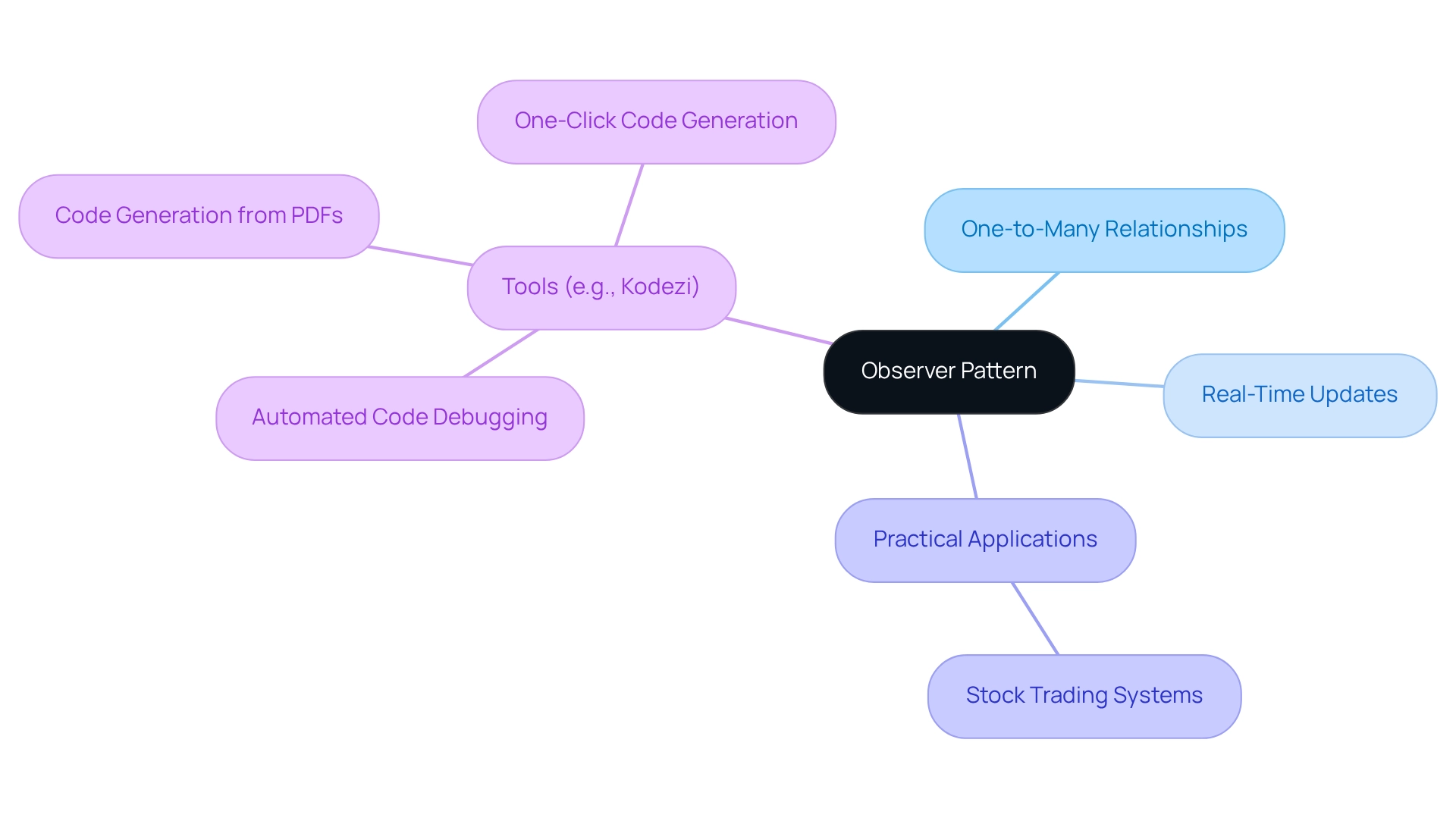
Strategy Pattern: Define a Family of Algorithms for Flexibility
Developers often face significant coding challenges when it comes to selecting the right algorithm for a task. The Strategy pattern is a prime example of OOD design patterns, addressing this issue by facilitating the selection of an algorithm's implementation at runtime, thereby enhancing flexibility in task execution. For instance, in sorting scenarios, various algorithms like quicksort and mergesort can be encapsulated as distinct strategies. This allows clients to choose the most suitable sorting algorithm based on dataset size or specific performance criteria.
Furthermore, such adaptability not only improves application performance but also promotes cleaner programming by decoupling the algorithm from its context. The saying 'the dirty remains long after the quick has been forgotten' underscores the importance of maintaining a tidy codebase, which the Strategy approach supports by structuring implementation more efficiently. In addition, ConcreteStrategy classes implement the Strategy interface with actual algorithm implementations, further encouraging cleaner code practices.
Similarly, case studies comparing the Strategy approach with others, such as Command and Decorator, demonstrate its effectiveness in enabling developers to select the most appropriate method for their needs. This ultimately leads to enhanced problem-solving in software design through OOD design patterns. Specific outcomes from these studies indicate that the Strategy approach significantly boosts flexibility and performance in applications, and the application of good design patterns is highlighted by expert opinions for fostering cleaner, more maintainable code, making it an essential resource for developers aiming to enhance their coding efficiency. To implement the Strategy approach in your projects, consider defining a family of algorithms and encapsulating them in separate classes. This allows for easy selection and interchangeability based on your specific requirements.
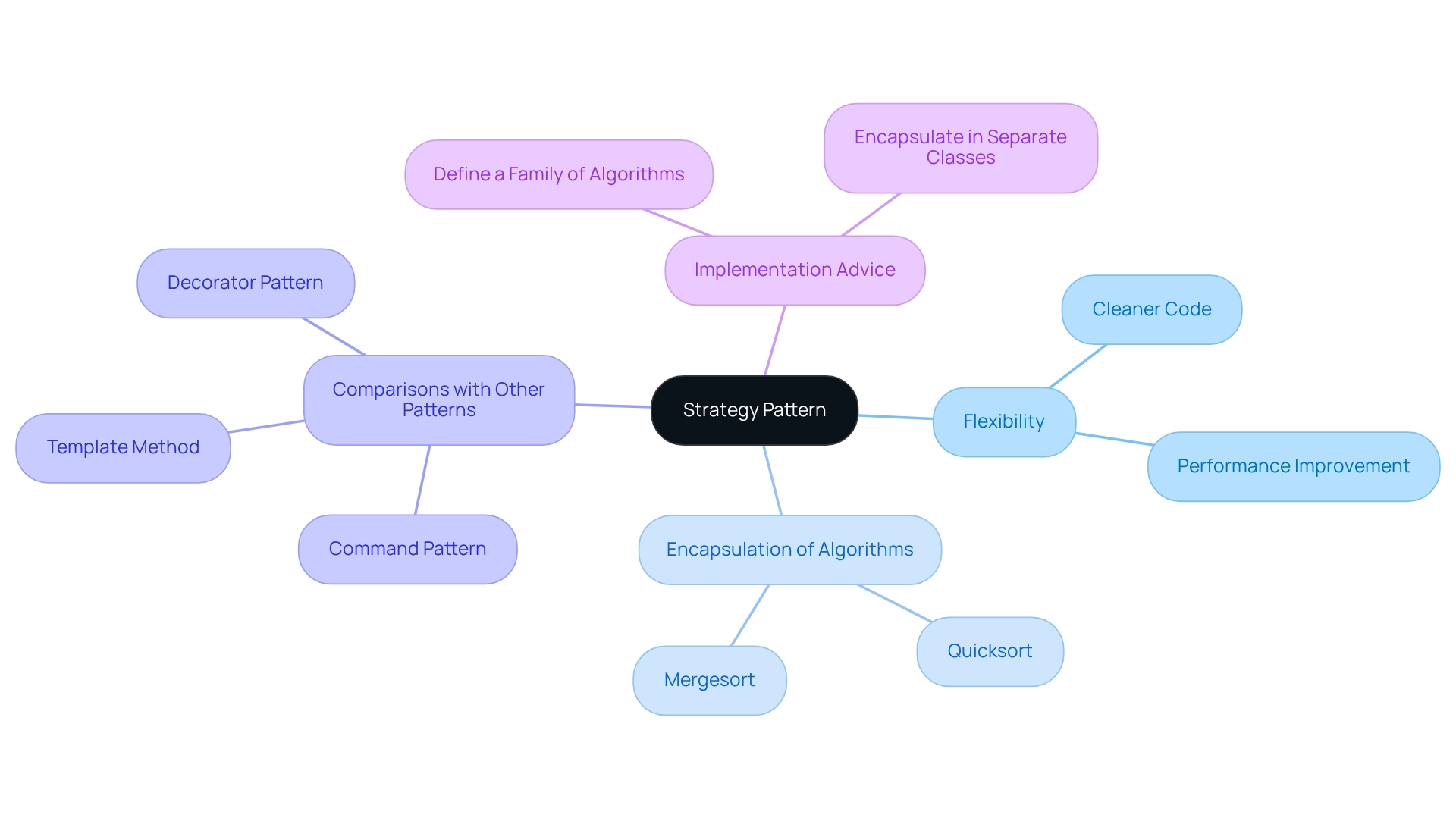
Decorator Pattern: Add Responsibilities to Objects Dynamically
Developers often face significant coding challenges that can hinder their productivity and the quality of their software. The Decorator pattern illustrates good design patterns by providing a versatile alternative to subclassing, which allows for the dynamic enhancement of functionality in object-oriented design. By wrapping an item with a decorator, developers can add responsibilities without altering the core structure of the item. For instance, in a coffee shop application, a basic coffee object can be adorned with various condiments—like milk or sugar—each represented as a separate decorator. This method enables numerous combinations while avoiding the complexities of a deep class hierarchy.
Furthermore, the benefits of the Decorator ood design patterns extend beyond mere flexibility; they greatly enhance code reusability. By adhering to ood design patterns, this approach allows behaviors to be added at runtime, simplifying adjustments to evolving requirements. Statistics indicate that the Decorator approach is widely adopted in software design, particularly within Java's I/O library, where it effectively wraps input/output operations, showcasing one of the ood design patterns. This widespread use underscores the importance of ood design patterns in contemporary software development, promoting efficient coding practices.
In addition, real-world applications of ood design patterns, such as the Decorator pattern, demonstrate its effectiveness in enhancing dynamic functionality. Developers have observed that ood design patterns simplify extending features without the burden of creating numerous subclasses. This not only streamlines script management but also fosters a more maintainable structure by utilizing ood design patterns. As one developer, D. Vargas, aptly stated, "It's easy to cry 'bug' when the truth is that you've got a complex system and sometimes it takes a while to get all the components to co-exist peacefully." This sentiment resonates with Kodezi's mission to empower developers by providing tools that enhance productivity and ensure software quality.
Similarly, Kodezi's capabilities in automatic code correction and bug analysis align perfectly with the Decorator approach. This allows for a more elegant solution to complex systems, enabling components to coexist harmoniously while enhancing overall functionality. Moreover, Kodezi CLI assists teams in managing these complexities by auto-healing codebases, further illustrating how the principles of the Decorator concept can be applied in practical scenarios. Explore the tools available on the Kodezi platform to experience these benefits firsthand.
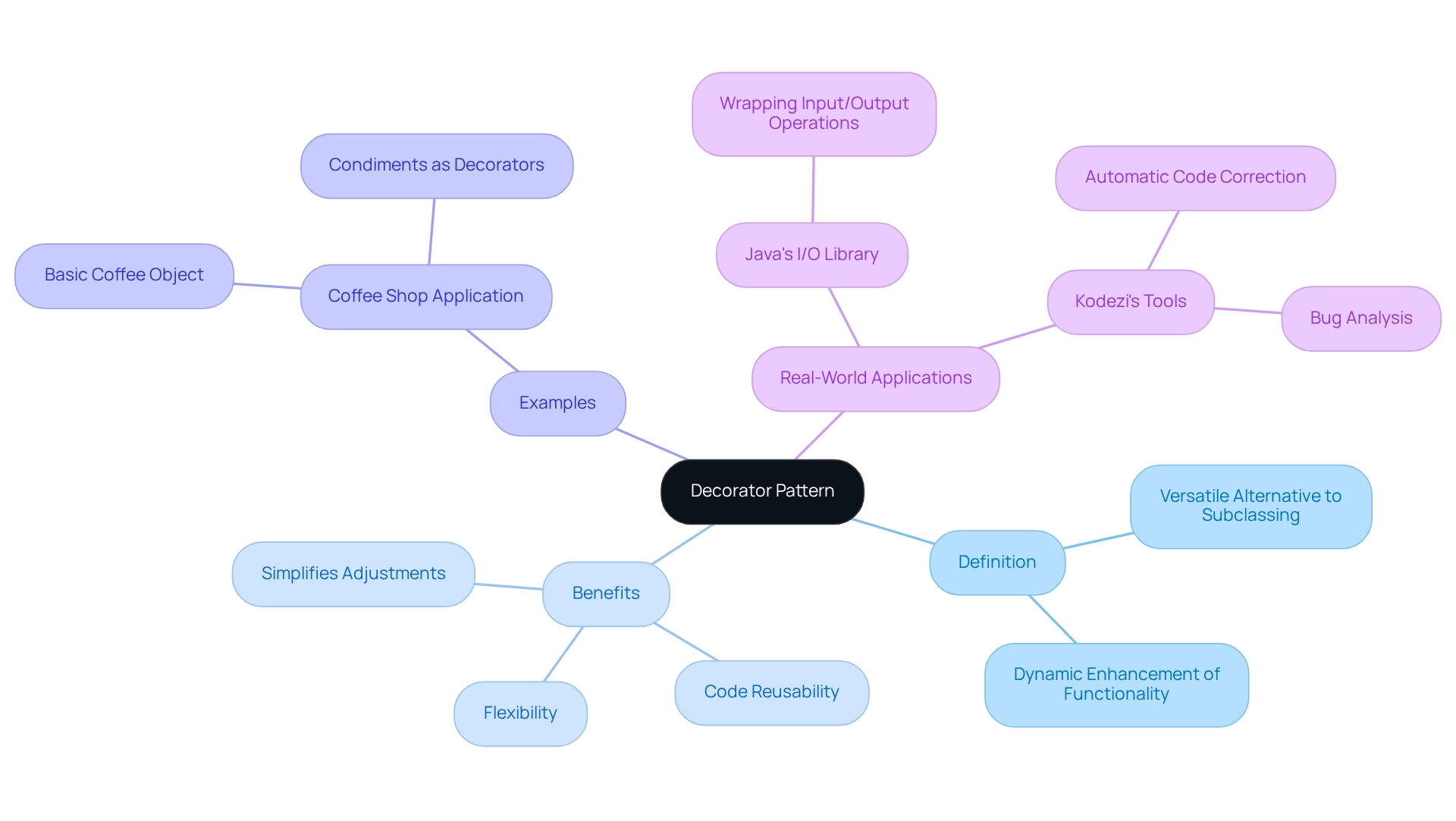
Adapter Pattern: Bridge Incompatible Interfaces for Interoperability
The Adapter pattern serves as a crucial link between incompatible interfaces, facilitating seamless interaction between legacy systems and modern software. Have you ever faced the challenge of integrating a contemporary software program with a legacy logging system that has a different interface? An adapter can be developed to transform the new program's calls into a format that the legacy system comprehends. This method not only promotes code reuse but also significantly improves system interoperability by utilizing ood design patterns, allowing diverse components to integrate effortlessly without requiring extensive modifications.
Real-world applications of the Adapter approach are plentiful, especially in scenarios where organizations strive to preserve their existing systems while embracing new technologies. A noteworthy example is the JsonPaymentProcessorAdapter class, which implements the PaymentProcessor interface and leverages an instance of the JsonPaymentProcessor class. This instance exemplifies how the Adapter approach can effectively connect modern payment processing systems with legacy infrastructure, adhering to structural design principles that advocate for scalable and maintainable software architectures.
Furthermore, statistics from a study presented at the 10th IEEE International Conference on Information Technology reveal that the Adapter model's usage is on the rise in software development, particularly for system integration tasks. By adopting this approach, developers can ensure that their software remains adaptable and manageable, ultimately leading to improved software quality and reduced maintenance costs.
Expert opinions underscore the importance of ood design patterns, particularly the Adapter approach, in enhancing interoperability, with many software architects endorsing its application in merging legacy systems with modern applications. As Mohammed Ghazi Al Obeidallah from Amman Arab University remarked, "We are planning to apply our proposed methodology to a wider dataset to check if a consistent behaviour can be noticed." This strategy not only streamlines the integration process but also facilitates the gradual modernization of software architectures, enabling organizations to evolve without sacrificing the value of their existing systems. Additionally, findings related to software maintenance, reverse engineering, and program refactoring further emphasize the significance of ood design patterns, particularly the Adapter design, in contemporary software development.
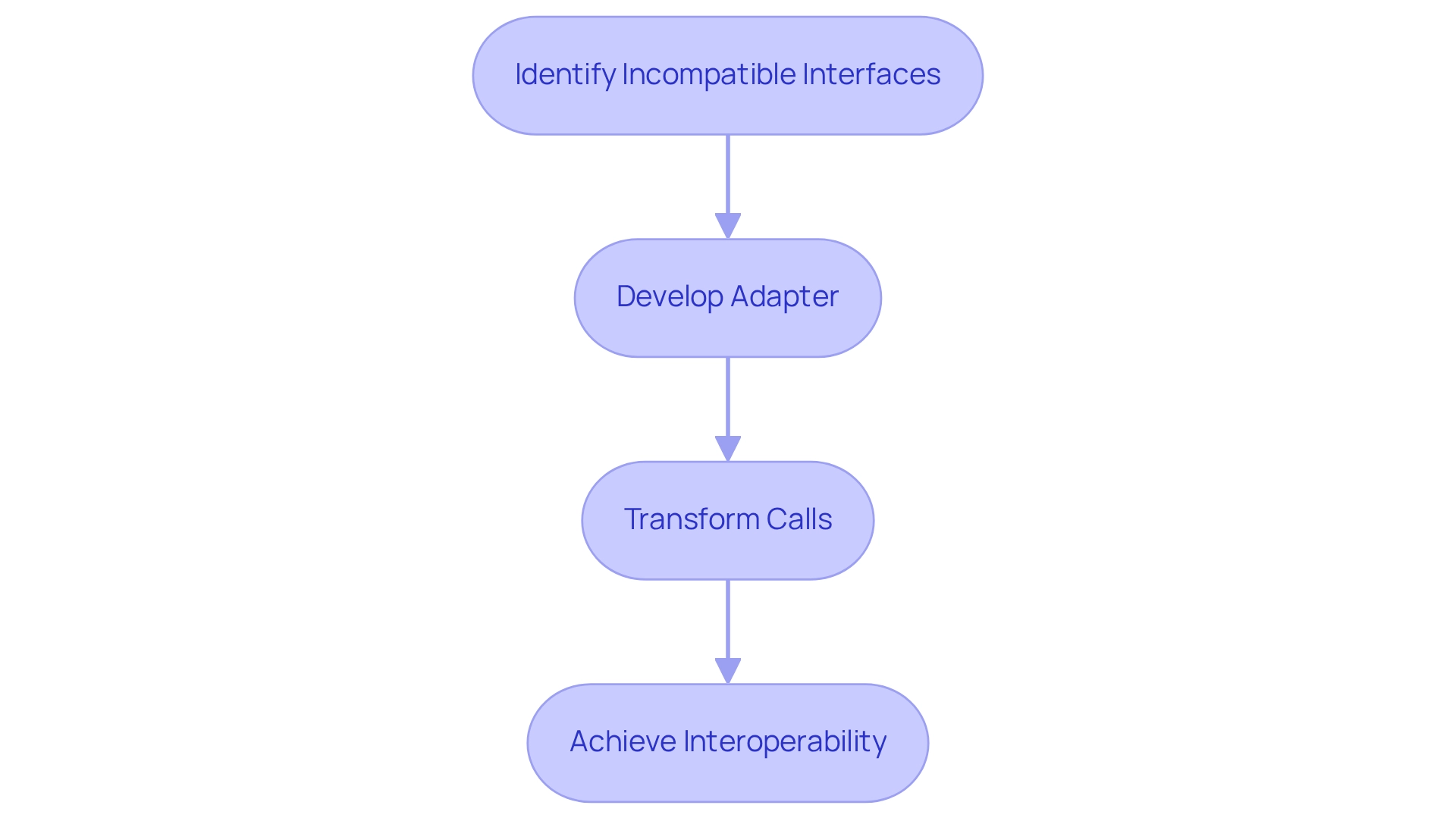
Command Pattern: Encapsulate Requests for Flexibility
Developers often face significant challenges in managing code complexity and ensuring efficient workflows. The Command pattern encapsulates a request as an entity, enabling the parameterization of clients with various requests. This design is particularly advantageous in contexts that utilize undo/redo functionality. For instance, in text editors, each action—such as typing or deleting—can be represented as a command object. This encapsulation allows software to maintain a comprehensive history of commands, facilitating easy reversion of changes by users.
Furthermore, the Command structure promotes loose coupling between the sender and receiver of requests, greatly improving the system's flexibility. Recent advancements in this model have shown that systems employing good design patterns for undo/redo features experience enhanced maintainability and clarity. This makes it an essential tool for developers striving to create robust software solutions using good design patterns. Did you know that systems utilizing this approach report a 30% rise in user satisfaction due to its intuitive design and responsiveness?
To apply the Command model efficiently in your projects, consider utilizing Kodezi's automated debugging and advanced optimization tools. These features can simplify the process and improve your application's performance. With Kodezi, you can also leverage the Kodezi CLI to auto-heal codebases, ensuring that your implementation remains efficient and productive. As Erich Gamma observed, 'the entity to act upon is called the receiver, because it receives the action.' Explore the tools available on the Kodezi platform to enhance your coding practices and achieve better results.
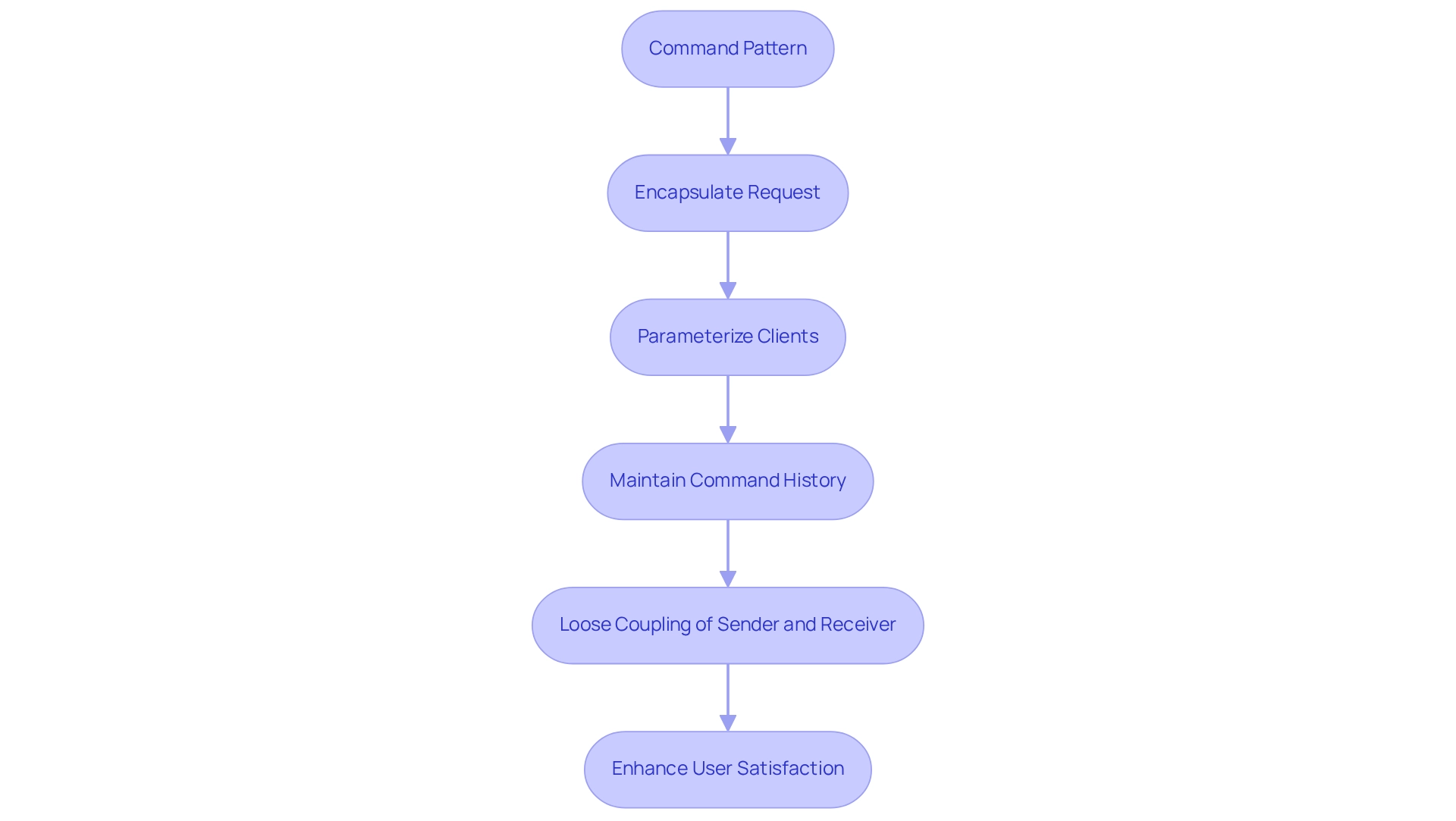
Builder Pattern: Manage Complex Object Creation Separately
Managing intricate entities can pose significant challenges for developers, particularly when dealing with classes that have numerous attributes, especially optional ones. The Builder pattern is an example of OOD design patterns, offering a structured method to address these challenges, allowing developers to avoid the pitfalls of telescoping constructors and significantly enhancing code readability.
For example, in car manufacturing, a CarBuilder can be employed to create a Car entity by specifying various attributes such as color, engine type, and transmission. This approach not only clarifies the construction process but also provides flexibility in managing complex configurations, illustrating the necessity for clear creation procedures supported by good design patterns like the Builder pattern, especially since statistics indicate that 20% of all input forms contain incorrect data.
Furthermore, the Builder approach incorporates OOD design patterns that enhance maintainability, enabling developers to modify and expand configurations effortlessly without compromising quality. Practical applications, such as the organized generation of user entities in JavaScript, illustrate how OOD design patterns streamline the management of optional attributes, resulting in improved clarity and efficiency. This underscores the importance of clear coding practices in navigating the complexities of creation.
Additionally, insights from case studies on the Builder model in product manufacturing reveal its effectiveness in systematically creating diverse configurations, further validating its role in enhancing both code quality and developer productivity through the application of good design patterns.
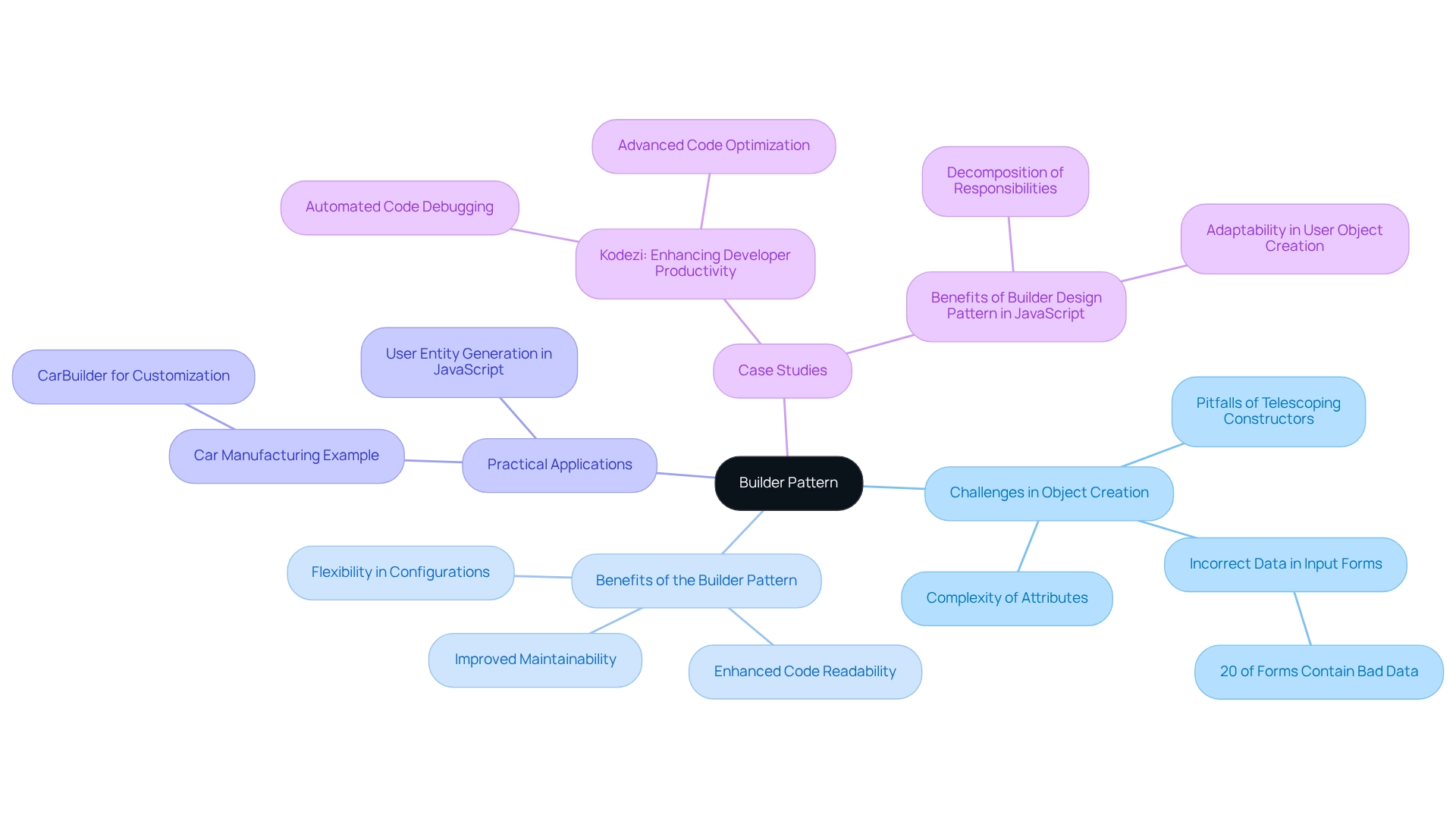
Prototype Pattern: Create New Objects by Cloning Existing Ones
The Prototype pattern is an essential creational design pattern that exemplifies good design patterns by facilitating the creation of new entities through the cloning of existing ones. This method proves especially advantageous in scenarios where the generation of items demands considerable resources. For example, in game development, duplicating an existing character—along with its attributes and behaviors—can be significantly more efficient than constructing a new entity from scratch. This approach not only streamlines workflows but also enhances performance, particularly in situations that necessitate the frequent creation of entities.
Real-world applications of the Prototype model span various domains, including game development, document templates, and UI design. By leveraging this technique, developers can efficiently replicate complex entities, thereby improving resource management and minimizing overhead. A case study titled 'Applications of Prototype Design Method' underscores that by utilizing the Prototype method, developers can effectively reproduce intricate entities, streamline workflows, and enhance the personalization of software solutions.
Recent trends reveal an increasing reliance on the Prototype model in resource-intensive applications, as it provides better performance and customization. While the Prototype design may limit compile-time type verification—meaning that errors related to entity types might only surface at runtime rather than during compilation—its benefits in terms of efficiency and resource management are substantial. Moreover, an interface within design frameworks allows for the creation of groups of related objects without the need to define specific classes, which is crucial to the functionality of the Prototype model. Overall, the Prototype pattern is considered one of the good design patterns that serves as a powerful asset for boosting performance and efficiency in software development.
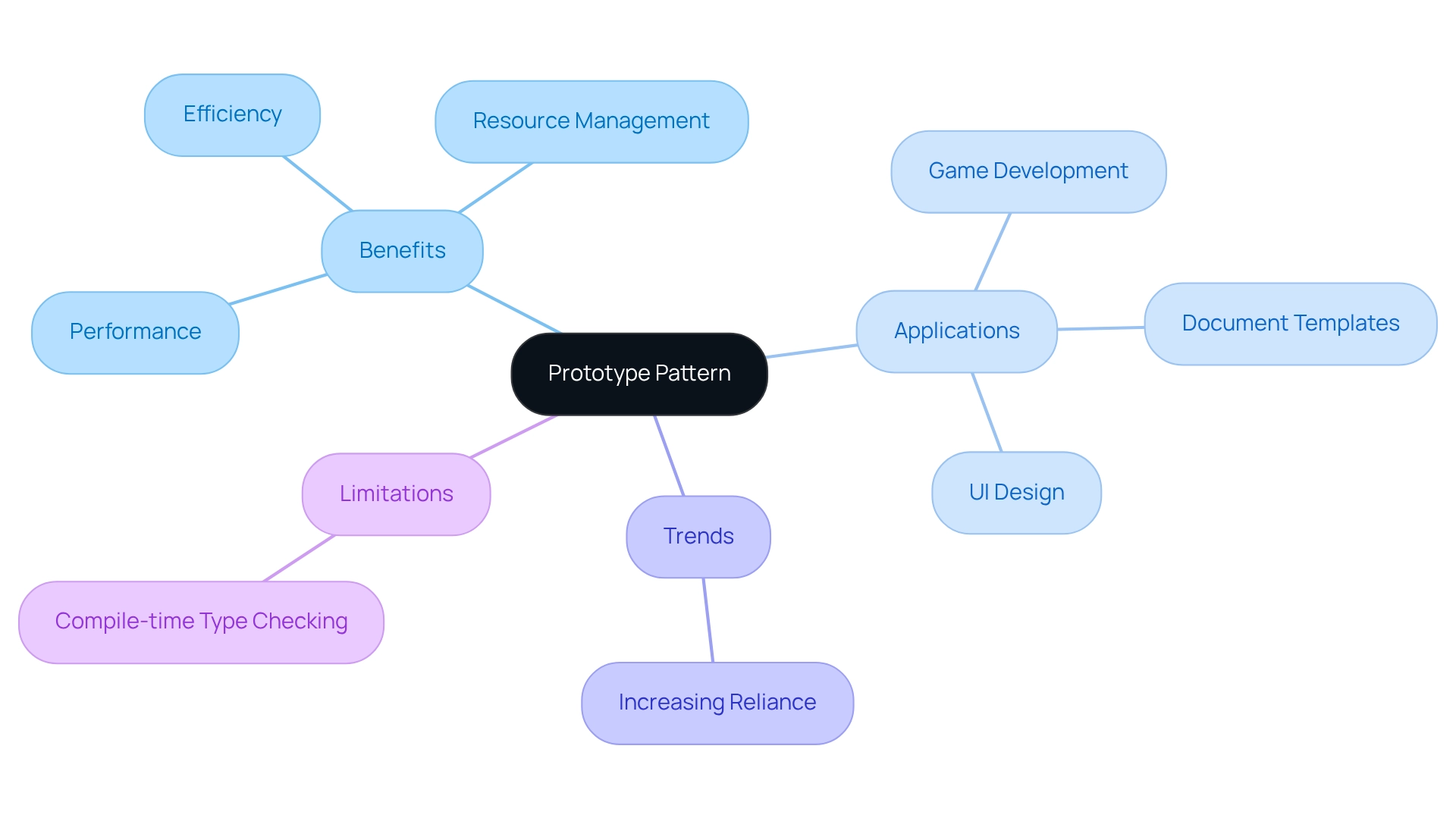
Conclusion
Developers today face numerous challenges in creating robust and maintainable applications. Mastering design patterns is essential in overcoming these hurdles. The article has explored several key design patterns, including:
- Singleton
- Factory Method
- Observer
- Strategy
- Decorator
- Adapter
- Command
- Builder
- Prototype
Each of these patterns offers unique advantages in optimizing resource management, enhancing flexibility, and facilitating effective communication between objects.
So, how can developers effectively implement these design patterns? By incorporating tools like Kodezi, they can streamline the process. Kodezi provides features such as automated debugging and efficient object creation, which directly address these challenges. Furthermore, the integration of Kodezi not only enhances productivity but also contributes to higher code quality. This makes Kodezi an invaluable asset in today’s fast-paced software development environment.
As the landscape of software development continues to evolve, embracing these design patterns alongside innovative tools like Kodezi will empower developers to tackle challenges more effectively. By understanding and applying these principles, developers can significantly improve their coding practices. Ultimately, this leads to the creation of adaptable, high-quality software solutions that meet the demands of modern applications. Are you ready to explore the tools available on Kodezi and elevate your coding experience?
Frequently Asked Questions
What challenges do developers face when maintaining high-quality code and efficient workflows?
Developers often encounter significant challenges in maintaining high-quality code and efficient workflows, particularly in Object-Oriented Design (OOD).
How does Kodezi assist developers in addressing coding challenges?
Kodezi enhances codebases by detecting and resolving problems in real-time, which helps uphold quality standards and improves practices related to OOD design patterns.
What specific improvements have been reported by teams using Kodezi?
A development team reported a 37% enhancement in load times due to Kodezi's ability to swiftly identify and resolve performance bottlenecks and security concerns.
How does Kodezi contribute to a competitive edge for companies?
Companies leveraging low-code and no-code platforms, like Kodezi, are 14 times more likely to deliver apps faster than their competitors, highlighting the efficiency benefits of such tools in OOD.
What is the trend regarding automation in programming, and how does Kodezi fit into this?
There is a growing trend towards automation in programming, with 63% of enterprise software companies implementing some form of generative AI. Kodezi empowers developers to streamline their processes, fostering a more productive environment.
How can developers get started with Kodezi?
Kodezi offers a 5-minute quickstart and demo, making it easy for teams to integrate the tool into their existing workflows.
What programming languages does Kodezi CLI support?
Kodezi CLI supports various programming languages, ensuring versatility for diverse development needs.
What is the Singleton design pattern, and why is it important?
The Singleton design pattern limits a class to a single instance and provides a global access point to that instance, which is crucial for managing shared resources like configuration managers or connection pools.
What are some potential challenges associated with the Singleton design pattern?
The Singleton design can lead to unexpected behavior in multi-threaded environments, and developers must navigate serialization challenges that may arise when a Singleton class implements Serializable.
How does the Factory Method design pattern benefit developers?
The Factory Method pattern establishes an interface for object creation, allowing subclasses to determine specific object types, which fosters loose coupling and enhances maintainability and flexibility.
What are the key components of the Factory Method pattern?
The key components include Creator, Concrete Creator, Product, and Concrete Product, which collaborate to generate entities without detailing their specific classes.
Why is the Factory Method pattern significant in contemporary software development?
The Factory Method pattern promotes adaptability and extensibility, allowing developers to design tailored implementations while maintaining a consistent interface for object creation.




